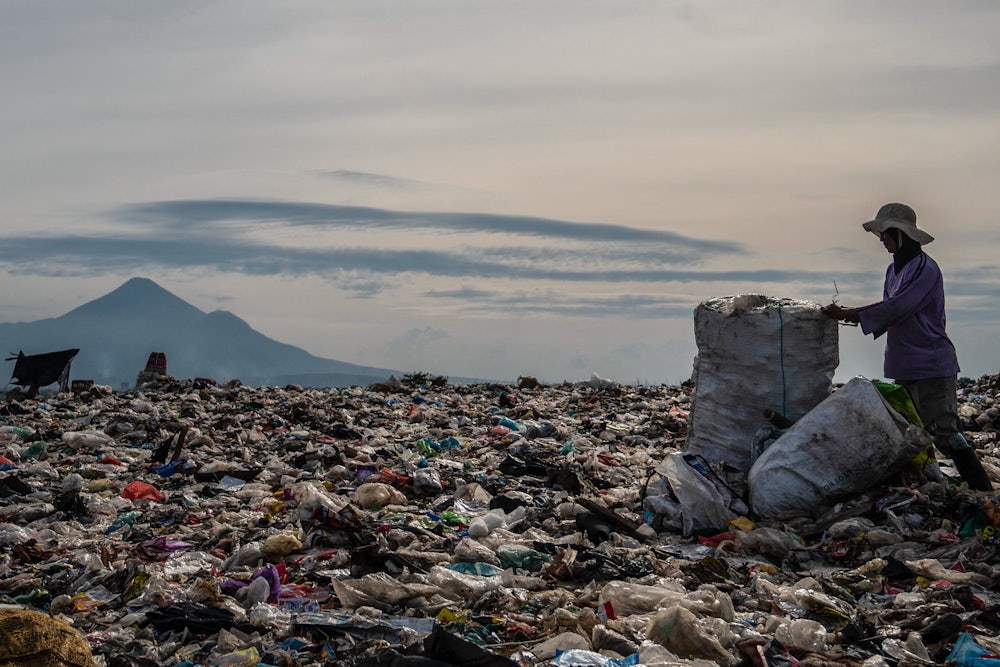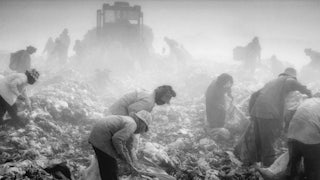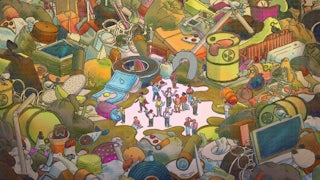“Here we have a man whose job it is to gather the day’s refuse in the capital,” wrote Charles Baudelaire, invoking the ragpicker, a new type on the streets of his native nineteenth-century Paris. “Everything that the big city has thrown away, everything it has lost, everything it has scorned, everything it has crushed underfoot, he catalogs and collects.”
Buried in Baudelaire’s descriptions of ragpickers are processes that historians have recently laid bare. With industrialization came the rise of consumer culture, and with consumer culture came the rise of disposal culture. Add unfettered fossil fuel use and the invention of single-use plastics and we arrive at the ragpickers of today: people in Indonesia climbing mountains of trash, or children scavenging for survival in the slums of Delhi or Manila or northeastern Brazil. Consumer lifestyles in high-income nations have clogged the oceans with garbage and broken our recycling systems. Only 9 percent of the world’s plastic waste is recycled, according to the Organization for Economic Co-operation and Development, but plastic consumption is on track to triple by 2050. Running out of places to put our daily detritus, the United States and the European Union export hundreds of millions of tons of garbage each year to poorer nations where it is landfilled, littered, or burned.
In two new books, the rise of recycling is a story of illusory promises, often entwined with disturbing political agendas. In Empire of Rags and Bones, Anne Berg, a historian at the University of Pennsylvania, examines one of the first modern recycling systems: the “waste regime” of Nazi Germany, where planners and engineers devised programs to recycle metal, rags, and paper; repurpose wires, cables, and railroad equipment; compost kitchen scraps; and collect old shoes, utensils, and junk—all in the service of a genocidal war.
In Total Garbage, journalist Edward Humes picks up the story of recycling from the postwar era to the present. His dive into the teeming wastes and faltering waste management systems of the United States shows that most recycling is a charade, a form of carefully constructed greenwashing that belies the fact that most postconsumer waste, including packaging, clamshells, films, pouches, boxes with windows, bags, and food containers, was never designed to be recycled.
Rather than being a virtuous act or an effective practice, recycling has been a feature of destructive systems that exploit labor and natural resources. We need a better way to think about our trash, and even more so, our consumption.
Scientists were decades away from discovering the planet-warming effects of carbon dioxide when millions of Germans took up recycling with near-religious fervor. It wasn’t environmental concerns that energized mass campaigns to eradicate waste, but a war economy. This was not unique to Germany: Across the British Empire and the United States, World War II catalyzed public and private efforts to persuade citizens to salvage metals, paper, and objects that could be used to make munitions. But in Germany, recycling campaigns were compulsory and extreme, bound up with the regime’s plans for total war and the total mobilization of the population. Lacking overseas colonies (the post–World War I settlement stripped the Reich of its imperial holdings), Germany was strapped for raw materials. In 1936, preparing for war, Nazi leaders announced a Four-Year Plan, a series of economic measures that introduced recycling regulations and mandated waste avoidance strategies. In the Nazi imagination, Berg tells us, waste was an abundant resource that could be exploited, cycled through the economy in a zero-waste scheme to extract value from existing goods. The solution was to uncover the hidden value of waste. Lurking in the people’s garbage were the resources to fuel Germany’s expansion, the sole guarantee of the Reich’s security and racial purity.

A 1938 book by Claus Ungewitter, the head of the regime’s Office of Chemistry, served as the Nazi “garbage bible,” Berg writes. Ungewitter’s scientific treatise outlined how value could be recovered from manufacturing processes and from old rags, sewage, and municipal waste. During World War I, Europeans had collected scrap for the first time, Ungewitter noted, detailing how Germans contributed to the war effort by rounding up paper, rubber, kitchen discards, lamp sockets, celluloid, and early plastic. He believed that Germans could go much further by irrigating agricultural fields with sewage, melting down fences and door hinges to recover metal, churning out briquettes from coal dust, and converting garbage slag to make cement and build roads. Nazi bureaucrats soon took Ungewitter’s ideas into S.S.-owned industries and concentration camps, concocting ways to wrest value from waste and inventing new uses for old materials.

The details of Nazi waste reclamation are gory: There are slippers made of hair and a disgusting “garbage sausage” that sickened any prisoner forced to eat it. There are crates of gold teeth and mountains of garments and shoes, objects that entered the visual record in 1945 as an illustration of Nazism’s murderous designs. The piles of glasses and teeth that confronted Allied troops entering the camps show how coordinated and comprehensive the regime’s efforts were to extract value from waste, using the labor of those it condemned to death.
While these atrocities became synonymous with a civilizational breach, they grew out of Europe’s racist, brutal history of colonial rule. As Nazi imperial planners prepared for the conquest and depopulation of the east, and calculated allocations of food and other resources, they studied other colonial powers. Just as Europe’s colonial empires plundered gold, timber, cotton, spices, and fossil fuels, “the imperial visions of the Third Reich, too, were focused on natural resources,” Berg writes, “such as iron, oil, and fertile soil, and the Nazis robbed whatever luxury goods they could get their hands on.” In the end, the contingencies and pressures of war led the Nazi empire to extract gold from people, rather than land, and resources from slave laborers instead of nature. Concentration camp prisoners, POWs, and deportees from enemy nations unloaded trains crammed with junk, scrapped metal, and squeezed value from every available textile. Ordinary Germans, meanwhile, proved eager to display their commitment to the future and became dedicated recyclers. In Berg’s telling, the Volksgemeinschaft was also a Müllgemeinschaft (garbage community), and even down to the regime’s final weeks with Allied troops closing in, Germans clung to the fantasy that old textiles and piles of rubble could be recycled into weapons of war, leading them to final victory.
In Berg’s story, this chapter in the history of recycling is about war and imperial exploitation. Perhaps even more confounding is that today, books about Nazi Germany fill libraries, and yet historians have somehow failed, until now, to grasp the ideological and strategic importance of recycling. As Berg makes clear, waste is everywhere in the archives—the Nazis rarely hesitated to create a bureaucracy (or a paper trail)—and yet scholars couldn’t see it. Our systems are designed to make waste invisible, at least for those of us who produce most of it.
It wasn’t just recycling but also plastic that emerged from war. The difficulties of rubber extraction and a worldwide ivory shortage led to the 1907 invention of Bakelite, the first synthetic plastic, a process Jeffrey L. Meikle traces in American Plastic: A Cultural History. Bakelite could be molded and machined and proved more versatile than labor-intensive rubber or ivory, once the preferred material for European makers of boxes, buttons, combs, and piano keys. The decimation of African and Indian elephant herds thanks to European hunters also spurred the invention of celluloid, another hard, durable substance that originated in nature (its inventor combined nitrocellulose with the sap of the laurel tree), only to be replaced by heat- and water-resistant Bakelite. It was Europe’s colonial quest for raw materials, its booming consumer markets, and then the chemical and war-making industries that created and popularized plastic. The U.S. military, eager to conserve precious rubber, contributed to plastic’s spread in World War II by using it in fuses, parachutes, airplanes, antenna housing, bazooka barrels, helmet liners, and combs distributed to service members as part of a hygiene kit.
The 1960s ushered in the dawn of single-use plastics, when shopping bags, straws, tubs, utensils, and food wrap became exceedingly cheap to produce and convenient to use, as long as no one paid attention to where it was going. When the first curbside recycling programs appeared in the 1970s, just as U.S. landfills started running short on space, the point of recycling was no longer to mine an untapped resource, or to get the most out of old stuff, but simply to find a place to put it.
Some three decades later, the accumulation of plastic wastes led the U.S. to look abroad for dumping destinations. By the 1990s, half the plastic Americans chucked into the recycling bin “was stuffed onto giant container ships and sold to China,” instead of making it to the local recycling center, says Humes. “Why invest in expensive technology and labor to keep up with the constantly changing world of packaging and plastics when the mess could be bundled off to China in exchange for easy money and the appearance of being green?”
There is a chasm, Humes points out, between “theoretical recycling” and “actual recycling.” (The chasing arrows symbol is a lie: The majority of plastic types captured by the arrows are considered “financially unviable” to recycle.) In 2018, China banned most imports of plastic, meaning that recyclables collected in the United States could no longer be shipped out of sight, out of mind. Instead of bringing in easy revenue by sending waste to China, U.S. cities, towns, and waste companies now faced staggering costs, and as a result, recycling fell off a cliff. The pandemic’s disruptions of global supply chains only exacerbated the problem of sending junk to other countries. Mexico, Vietnam, Malaysia, and other nations now absorb a portion of our waste, “a global hot potato,” as reporters referred to it in The Guardian. The bulk of this waste (more than 80 percent) is mismanaged, often dumped in open landfills, according to researchers. The flow of plastic from rich countries to poorer ones, glutting waterways and leaching harmful chemicals into the environment, recalls colonial-era destructiveness. Reading Humes’s book alongside Berg’s, the overwhelming takeaway is that waste management perpetuates systems of domination and oppression. Under Nazism, waste was a resource, while under capitalism, waste is a commodity.
Humes reports on garbage changemakers—individuals and communities scattered across the country that have come up with new ways to mitigate waste. There’s the father-son team behind Seattle’s Ridwell, which collects and repurposes single-use, zombie trash that refuses to die. Or Sarah Nichols at Maine’s Natural Resources Council, whose efforts to shift the burden of waste disposal from consumers to producers resulted in a 2021 law that levies fees on producers and sellers of packaging and containers to foot the bill for actual recycling. Several college campuses have diverted much of their waste from landfills while ditching fossil fuels. The trash cognoscenti, as Humes calls them, understand that everything must begin with the end in mind. Zero-waste is the goal, and recycling won’t get us there.
The best way to solve our garbage crisis, Humes suggests, is to produce less of it in the first place. He intersperses his reporting with thoughts on how to prevent food waste, how to shop package-free, and how to participate in resale and secondhand economies. Citizen-consumers have power, he notes, to buy less; to live, work, and study in low-waste ways; to vote for better policies, and to model change in our communities. Instead of taking out the trash without mulling over where it’s going, for Humes, the key is to “think about what will happen to a product or package at the end of its useful life.”
Berg’s history of Nazi recycling concludes with a reminder: “Waste is supposed to be invisible.” Since the nineteenth century, not seeing our trash has been a marker of civilization and progress. Modern sanitation and urban infrastructure carried away our waste, enabling us to produce more of it. What Berg and Humes tell us is that destructive values and oppressive power structures are embedded in our garbage. To exist and persist, our systems make waste. The first step toward change is to start seeing what is hidden in plain sight.






